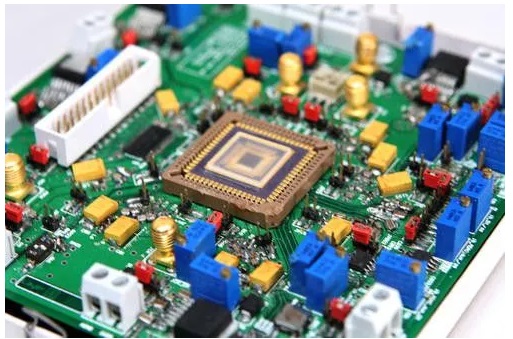Analog integrated circuits mainly refer to integrated circuits composed of capacitors, resistors, transistors, etc. that are integrated to process analog signals. There are many analog integrated circuits, such as operational amplifiers, Analog multipliers, phase-locked loops, power management chips, etc. The main components of analog integrated circuits include amplifiers, filters, feedback circuits, reference source circuits, switched capacitor circuits, etc.

Analog Integrated Circuits
Characteristics of Analog Integrated Circuits
Compared with digital integrated circuits, special components in analog integrated circuits have their characteristics in terms of component usage and circuit structure.
1: The accuracy of individual components is not very high and is also greatly affected by temperature. However, components manufactured using the same process on the same silicon wafer have relatively consistent performance or better symmetry of the components.
2: Because the components in the circuit are all concentrated on the same silicon chip and are very close to each other, the temperature difference is not significant, and the temperature characteristics of the same type of components are the same, so the temperature symmetry is good.
3: The resistance range of a resistor has certain limitations, usually between tens of ohms to tens of thousands of ohms, and it is not easy to manufacture if it is too high or too low.
4: The capacitance generally does not exceed 100pF, and large capacitors are not easy to manufacture. As for inductance, it is limited to very small values and should be avoided as much as possible.
5: The p-value of the longitudinal npn tube is relatively large, while the p-value of the transverse pnp tube is very small, but its pn junction withstand voltage is high. Among various integrated components, longitudinal NPN transistors occupy a small area and perform well, while resistors and capacitors occupy a large area and have a narrow range.
Principles of Analog Integrated Circuits
In information technology, digital integrated circuits play a leading role in processing information carried by digital signals, which take discrete values in terms of time and quantity. However, the changes in time and quantity of signals in nature are continuous, such as wind sound, water flow, etc. These signals are called Analog Signals. Correspondingly, the circuits used to process analog signals are called analog circuits, while the integrated circuits used to process analog signals are called analog integrated circuits. Digital circuits cannot directly interact with nature, just for the convenience of processing or transmission. To fully utilize the advantages of digital systems, analog signals are first converted into digital signals, input to modern digital systems with high capacity, high speed, strong anti-interference ability, and good confidentiality, and then re-converted into analog signal outputs.
The protagonist of integrated circuits is transistors, and analog integrated circuits are no exception. However, they utilize the amplification effect of transistors, while digital integrated circuits utilize the switching effect of crystals. Most of the early analog integrated circuits used bipolar junction transistors. Due to the maturity of CMOS technology, it overcame the disadvantage of the slow speed of the early CMOS circuit and has the advantages of low power consumption and convenient process upgrading (the equal proportion of CMOS is reduced). Now analog integrated circuits and digital-analog mixed integrated circuits (digital circuits and analog circuits are integrated) are also commonly designed and implemented using CMOS.
Classification of Analog Integrated Circuits
Analog integrated circuit products are divided into three categories: the first category is general-purpose circuits, such as operational amplifiers, multipliers, phase-locked loops, active filters, and analog-to-digital and analog-to-digital transformations; The second type is specialized integrated circuit series, such as audio systems, television receivers, video recorders, and communication systems; The third type is single-chip integrated systems, such as single-chip transmitters, single-chip receivers, etc.
Application of Analog Integrated Circuits
The basic circuits of analog integrated circuits include current sources, single-stage amplifiers, filters, feedback circuits, current mirror circuits, etc. The higher-level basic circuits composed of them are operational amplifiers and comparators, while the higher-level circuits include switched capacitor circuits, phase-locked loops, ADC/DAC, etc. According to the response relationship between the output and input signals, analog integrated circuits can be further divided into two categories: linear integrated circuits and nonlinear integrated circuits.
The response between the output and input signals of the former is usually linear, and the shape of the output signal is similar to the input signal, except that it is amplified and amplified by a fixed coefficient. The response of the output signal of the nonlinear integrated circuit to the input signal shows a nonlinear relationship, such as a square relationship, logarithmic relationship, etc., so it is called a nonlinear circuit. Common nonlinear circuits include oscillators, timers, phase-locked loop circuits, etc. The typical application of analog integrated circuits is shown in the following figure. The external natural signals collected by various sensors or antennas, such as temperature, humidity, optics, piezoelectric, and acoustic, are preprocessed by analog circuits and converted into appropriate digital signals for input into the digital system; The signal processed by the digital system is then processed through an analog circuit and converted into analog signals such as sound, image, and radio waves for output.
How to handle analog signals in PCB design?
Due to the continuous nature of the analog signal, voltage changes have a significant impact on the analog signal, and the analog signal is ultimately a voltage signal. Therefore, it is usually necessary to thicken the wiring to 10-15mil in conventional PCB design.
Secondly, the anti-interference ability of analog signals is relatively poor, so isolation and reference ground should be considered. Isolation first involves separating the digital area from the analog area and separating the digital and analog areas to avoid cross-talk between them.
Analog integrated circuits are very important electronic devices that can complete various signal-processing tasks and have wide applications in various fields.